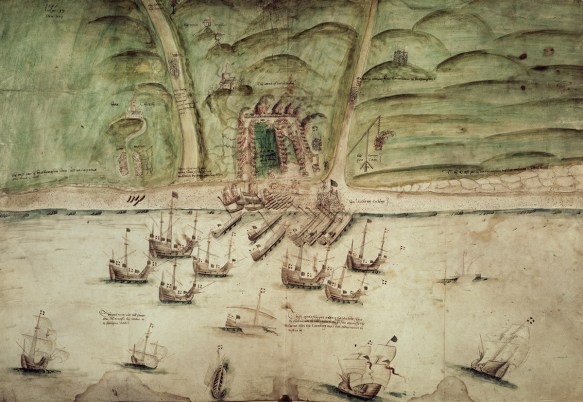French raid on Brighton, 1514 Anglo-French naval conflict in the early sixteenth century was a period of transition from medieval naval warfare, which had been dominated by coming alongside and boarding, to stand-off tactics in which warships put more of an emphasis on firepower and did not come into direct contact. In the war of 1512–14, the English and French fleets fought in the Channel in the traditional fashion, whereas off Portsmouth in 1545 they engaged in a gunnery duel. This shift had important implications for naval tactics (although truly effective ways of deploying naval firepower were not found until the next century), and it further encouraged the development of warships primarily as artillery platforms. Carvel building (the edge joining of hull planks over frames) replaced the clinker system of shipbuilding using overlapping planks, contributing to the development of stronger hulls better able to carry heavy guns. The Anglo-French War of 1512–14 saw Henry VIII support Spain, Venice and the Pope, and naval operations were a part of this wider struggle, one ultimately determined by developments in Italy. The Channel was in practice a sideshow.
The precise date of the attack is uncertain, but it is believed to have taken place in the first few days of June. In his book Life in Brighton, Clifford Musgrave, a former director of the Royal Pavilion and Museums, notes that ‘State Papers dated from Calais 5 June 1514… speaks of arrangements for a raid to be carried out in France “in revenge for the burning of Brighthelmstone”‘
The attack was led by a feared foe of the English, a French naval commander known by various forms of ‘Prior John’. An account of the raid was published in Holinshed’s Chronicles, a popular Tudor history book that was used as a reference by Shakespeare and others.
According to Holinshed, Prior John and his men succeeded in burning and looting most of the village before English reinforcements arrived. The invaders were attacked by a hail of arrows, and Prior John was struck in the eye. Miraculously, Prior John survived the wound, and as a gesture of thanks, presented a wax image of his face, also depicting the arrow in his eye, to a church in Boulougne.
In spite of this moment of piety, Prior John and his men seem to have had little respect for religious buildings: the Priory of Bartholomew, which has given its name to a street next to Brighton Town Hall, was mostly destroyed by the raiders. St Nicholas’ Church was one of the few buildings to survive the raid, and this may be because it stood at the top of the hill overlooking the old town. If Holinshed’s account is correct (it was first published in 1577, over sixty years after the original attack), the invaders may have been unable to reach it before English reinforcements arrived.
Although the town was almost completely destroyed, it was rebuilt along the lines of the original streets, and the layout of the Lanes still reflects the shape of the town prior to the invasion.
War of the League of Cambrai
